Abstract
In this paper, the role of oceanic Rossby waves in climate variability is reviewed, as well as their dynamics in tropical oceans and at mid-latitudes. For tropical oceans, both the interactions between equatorial Rossby and Kelvin waves, and off-equatorial Rossby waves are privileged. The difference in the size of the basins induces disparities both in the forcing modes and in the dynamics of the tropical waves, which form a single quasi-stationary wave system. For Rossby waves at mid-latitudes, a wide range of periods is considered, varying from a few days to several million years when very-long-period Rossby waves winding around the subtropical gyres are hypothesized. This review focuses on the resonant forcing of Rossby waves that seems ubiquitous: the quasi-geostrophic adjustment of the oceans favors natural periods close to the forcing period, while those far from it are damped because of friction. Prospective work concentrates on the resonant forcing of dynamical systems in subharmonic modes. According to this new concept, the development of ENSO depends on its date of occurrence. Opportunities arise to shed new light on open issues such as the Middle Pleistocene transition.
1. Introduction
Rossby waves are huge, undulating movements of the ocean that stretch horizontally across the planet for hundreds of kilometers in a westward direction. They are so large and massive that they can change Earth’s climate conditions. They play a critical role in the transient adjustment of ocean circulation to changes in large-scale atmospheric forcing. Oceanic Rossby waves can be efficiently coupled to the overlying atmosphere, and that atmospheric coupling is capable of adding extra speed to the wave [1]. They promote heat exchanges between the ocean and the atmosphere as a result of the up and down motions of the thermocline. The uplift of the thermocline induces convective processes and stimulates evaporation and Sea Surface Temperature (SST) anomalies, as well. These conditions are favorable for the formation of baroclinic instabilities in the atmosphere, which can generate a low-pressure system. On the contrary, when the thermocline lowers, the subsurface waters behave like a heat sink, favoring the formation of a negative SST anomaly. Teleconnections within the atmosphere and ocean and their dynamics have an important role in coupled climate variability, notably in the latitudinal direction, including tropical–extratropical and interhemispheric interactions [2].
1.1. Ocean–Atmosphere Exchanges
Oceanic Rossby waves stimulate ocean–atmosphere exchanges mainly in tropical oceans and at mid-latitudes where western boundary currents such as the Gulf Stream and the Kuroshio extension move away from the continent to re-enter the subtropical gyre.
1.1.1. The Tropics
The resonance of tropical baroclinic waves occurs in all three oceans. This is because the westward-propagating Rossby waves, which are equatorially trapped, are retroflexed at the western boundary to form off-equatorial Rossby waves dragged by countercurrents before receding and turning back as Kelvin waves [3,4,5]. However, the difference in the size of the basins means that there are many disparities in both the forcing modes and the dynamics of these tropical waves, each of which forms a single quasi-stationary wave system. Their impact on the climate also varies from one basin to another, at the same time as their average period. Due to El Niño, the Pacific Ocean has a considerable impact on the climate on a planetary scale. Although its influence on the climate is more localized, the Indian Ocean is subject to the Indian Ocean Dipole (IOD) that arouses a lot of interest.
1.1.2. Mid-Latitudes
Outside of the tropics, the first observations concern Rossby waves abruptly amplified by major topographic features [6]. More generally, Ekman pumping associated with the wind curl forcing forces a gyre circulation, which consists of a slow interior Sverdrup flow [7] and an intensive western boundary return current [8,9]. This gyre circulation contributes to a significant poleward heat transport in the ocean [10,11]. Rossby waves propagating westward, embedded in the wind-driven current of the gyre, develop where the western boundary current leaves the continent to re-enter the subtropical gyre. Being approximately non-dispersive, these Rossby waves owe their existence to the fact that their phase velocity is lower than the velocity of the zonal wind-driven current of the gyre carrying them. For a fixed observer, these Rossby waves propagate eastward with an apparent wavelength that is proportional to the period.
1.2. Resonance of Baroclinic Waves
The resonance of baroclinic waves in the stratified oceans, whether equatorial or off-equatorial waves, is a topic that motivates sustained research. The resonance of a dynamical system formed from baroclinic waves requires the adjustment of its natural period to the forcing period. In the case of a pseudo-periodic forcing, the adjustment of the natural frequency is exerted when the average forcing frequency is present in the frequency spectrum of the dynamical system. Frequencies close to the forcing frequency are favored, while those far from it are damped because of friction. Therefore, the dominant frequencies are those for which the balance between the geostrophic forces and the forcing maximizes the mean energy captured. The adjustment of the dynamical system operates differently depending on whether it occurs in tropical oceans or at mid-latitudes.
In tropical oceans, systems whose dynamics are based on the round trips of Rossby and Kelvin waves along the equator tune on the forcing frequency thanks to the adjustment of off-equatorial Rossby waves to the west of the basin. The equatorial Rossby waves are deflected as they approach the western boundary to form off-equatorial waves dragged by a countercurrent. These off-equatorial waves flow back when the countercurrent is canceled or reversed. Rossby waves reflect off the western boundary of the basin to form equatorially trapped Kelvin waves. The dynamics of the baroclinic waves depend closely on the modulated component of the equatorial current and the countercurrents, which represent an integral part of the quasi-stationary system [12,13,14]: a linear, viscid, continuously stratified model was used in [15] to study the response of the equatorial ocean to forcing by a wind patch moving zonally.
For the Rossby waves at mid-latitudes, they propagate along the subtropical gyres from where the western boundary currents move away from the continent. The natural frequency of the Rossby waves is tuned to the forcing frequency thanks to the adjustment of their apparent wavelength. Since Rossby waves are approximately non-dispersive, their speed depends only on latitude [16]. These conditions are favorable to the formation of numerous harmonics and subharmonics.
1.3. Prospective Research
1.3.1. Subharmonic Modes of Rossby Waves
Multi-frequency quasi-stationary waves (QSWs) are endowed with a remarkable property, which gives them a role of primary importance both in ocean circulation and in the variability of climate. Indeed, they have the ability to be coupled when they share the same modulated currents, which generally occurs both in tropical and subtropical oceans. The coupling results from the alteration of the geostrophic forces of the basin as a consequence of the convergence and the merging of geostrophic currents.
These different properties make resonantly forced waves behave like coupled oscillators. In this case, a subharmonic mode locking occurs, which means the average periods of coupled QSWs are multiples of the period of the fundamental wave—that is, the dynamical system whose natural period coincides with the forcing period. This subharmonic mode locking of QSWs is based on the Caldirola–Kanai oscillator, which is a fundamental model of dissipative systems that is usually used to develop a phenomenological single-particle approach for the damped harmonic oscillator [17,18] (Appendix A).
1.3.2. Very-Long-Period Rossby Waves Winding around the Subtropical Gyres
Supported by both observational and theoretical considerations, recent work shows that long-period Rossby waves winding around subtropical ocean gyres play the role of mediator between solar and orbital forcing and climate response [19]. Propagating cyclonically around the subtropical gyres, the so-called gyral Rossby waves owe their origin to the gradient β of the Coriolis parameter relative to the mean radius of the gyres (Appendix B).
The velocity of the resulting modulated western boundary current is added to that of the steady anticyclonic wind-driven current. Consequently, acceleration/deceleration of the western boundary current according to the phase of gyral Rossby waves amplifies the oscillation of the thermocline because of a positive feedback loop ensuing from the temperature gradient between the high and low latitudes of the gyres. Multi-frequency Rossby waves overlap. They are forced by solar and orbital cycles in subharmonic modes. The efficiency of forcing considerably increases as the forcing period approaches a natural period.
These gyral Rossby waves are resonantly forced by the solar and orbital cycles, which involves tuning their apparent wavelength so that a natural period of the gyre coincides with the forcing period. The phase velocity of cyclonically propagating gyral Rossby waves depends only on the mean latitude of the gyre, in accordance with their dispersion relation (A11). On the other hand, the speed of the anticyclonically flowing wind-driven current of the gyre results from Ekman pumping associated with the wind curl forcing. Consequently, only the tuning of the average radius of the gyre to the forcing period allows the resonant forcing of the gyral Rossby waves. Gyre adjustment occurred during the Mid-Pleistocene Transition (MPT), as evidenced by climate records from marine sediment cores [19].
1.4. Solar Rossby Waves and Similar Implications in Space Weather
As Rossby waves are a pervasive feature of the large-scale motions of the Earth’s atmosphere and oceans, planetary waves also play an important role in the large-scale dynamics of different astrophysical objects such as the solar atmosphere and interior, astrophysical discs, rapidly rotating stars, and planetary and exoplanetary atmospheres. The physical role played by Rossby waves is discussed in [20] in the context of solar and stellar magnetic activity, angular momentum transport in astrophysical discs, planet formation, and other astrophysical processes.
Rossby waves arise in thin layers within fluid regions of stars and planets. These global wave-like patterns occur due to the variation in Coriolis forces with latitude. Notably, Rossby waves have been detected in the Sun’s photosphere and corona. They originate in the solar tachocline, the thin shear layer between the solidly rotating radiative interior and the convection zone, where a differential rotation occurs. Helioseismology shows that the tachocline is located at a radius of at most 0.70 times the solar radius, with a thickness of 0.04 times the solar radius. Simulations of magnetohydrodynamics of tachocline Rossby waves and magnetic fields produce strong “tachocline nonlinear oscillations”, which have periods similar to those observed in the solar atmosphere [21,22]. Solutions show that Rossby waves undergo irregular switches between periods of high activity and periods of suppressed activity, resembling the Maunder minimum [23].
2. Tropical Oceans
2.1. The Atlantic Ocean
Three main basin modes are highlighted in the tropical Atlantic: (1) a 1-year period QSW formed from gravest mode baroclinic planetary waves, which consists of a northern, an equatorial, and a weaker southern antinode (Figure 1a,b), and a major node off the South American coast that straddles the north equatorial current (NEC) and the north equatorial counter current (NECC) [24,25,26]. The modulated component of the South Equatorial Current (SEC) is another node in the eastern part of the basin (Figure 1c,d). The other two main basin modes are (2) a half-a-year period harmonic [26,27] and (3) an 8-year subharmonic [12,28].
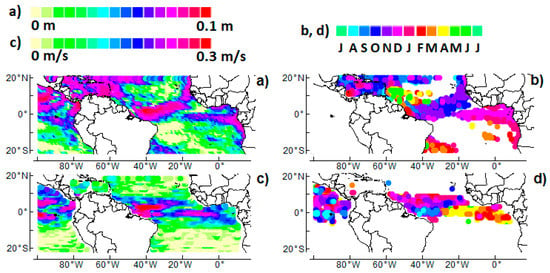
Figure 1.
(a,b) Amplitude and phase of Sea Surface Height (SSH) anomalies; (c,d) velocity and phase of zonal geostrophic currents (faces west when phase is zero). The amplitude and the phase are averaged over the 8–16 month band (years 2000–2001). From [12], Figure 2, with kind permission Copyright 2022 from Pure and Applied Geophysics.
The integrity of the dynamical system formed from tropical Rossby waves, on which the notion of annual QSW is based, is pointed out by a study [29] that revealed that the interaction between the meridional and zonal modes is mediated by directly wind-forced equatorial Kelvin waves and the delayed negative feedback from western boundary reflections of wind-forced Rossby waves.
Forced by trade winds, the main SSH anomaly, located between 0° and 5° N, peaks in November. The second, which extends along the equator in the eastern part of the basin, peaks in January. At the western boundary of the basin, the equatorial Rossby wave is deflected along the NECC. When the NECC vanishes or reverses, off-equatorial waves recede as an equatorially trapped Kelvin wave, being deflected off the western boundary [12,30]. At the eastern boundary, the Kelvin wave splits into coastal Kelvin waves that flow mainly southward to leave the Gulf of Guinea.
The NECC is a major component of the climate system and flows generally eastward between about 3° and 10° N, bounded by the westward NEC and the northern branch of the SEC. SST anomalies highlight a zonal equatorial mode controlled by the NECC, and a meridional mode (Figure 2). Ocean–atmosphere mechanisms that lead to the Atlantic zonal equatorial mode share some characteristics with the Pacific El Niño–Southern Oscillation mode [27]. Although much smaller than observed in the tropical Pacific, the SST anomalies appear significant, with systematic links to regional climate anomalies [31].
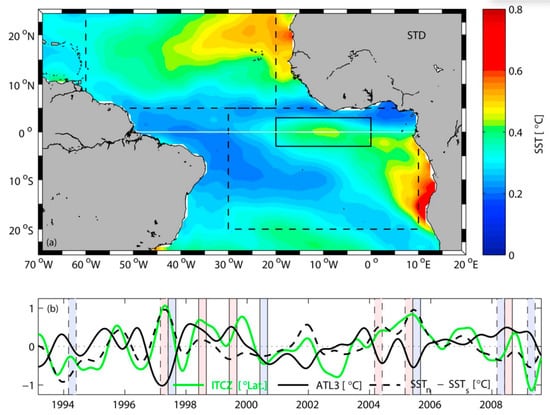
Figure 2.
(a) Standard deviation of interannual SST anomalies in the tropical Atlantic. Black lines mark the ATL3 region (solid) as well as northern (SSTn) and southern (SSTs) boxes (dashed) used to form the meridional mode index (SSTn–SSTs). White line indicates the equator. (b) ATL3 (black solid) and SSTn–SSTs (black dashed) time series, along with interannual Inter Tropical Convergence Zone (ITCZ) position anomalies (green). Shadings are the three warmest (red) and coldest (blue) years during the peak season of the meridional (March–May; black dashed contours) and zonal (June–August; black solid contours) modes, respectively. From [32], Figure 9, with kind permission Copyright 2022 from the Journal of Geophysical Research.
During boreal spring, conditions in the tropical Atlantic are favorable for the development of an anomalous interhemispheric SST gradient, giving rise to the meridional mode. The wind–evaporation–SST feedback mechanism appears to be an important driver of this thermodynamic mode (e.g., [33]). Positive feedback is strongest in the western Atlantic warm pool region where the NECC originates.
The most notable climate impacts of these two dominant modes in the tropical Atlantic are the variability of rainfall over northeast Brazil and the coastal regions surrounding the Gulf of Guinea, as well as fluctuations in rainfall and dustiness in sub-Saharan Africa (Sahel) [34,35,36,37,38,39]. A possible mechanism for the occurrence of severe droughts over northeast Brazil is the warming due to enhanced moist convection associated with warmer SST anomalies over the northern tropical Atlantic, and cooling associated with colder SST anomalies in the southern tropical Atlantic [35].
2.2. The Pacific Ocean
2.2.1. The El Niño–Southern Oscillation
El Niño–Southern Oscillation (ENSO), which occurs in the tropical Pacific, has a significant impact on global climate. A warm SST anomaly in the equatorial eastern Pacific reduces the east–west SST gradient and hence weakens the Walker circulation [40,41]. The resulting westerly wind anomaly in turn drives the ocean circulation change that further enhances the SST anomaly. This positive ocean–atmosphere feedback in the tropical Pacific hypothesized by Bjerknes [42] leads the ENSO event to a mature phase.
After an ENSO event matures, negative feedbacks are needed to cease the ENSO anomaly growth [43]. Four negative feedbacks have been proposed: (i) reflected Kelvin waves at the ocean western boundary; (ii) a discharge process due to Sverdrup transport, i.e., the geostrophic transport in the ocean from the wind stress field; (iii) western Pacific wind-forced Kelvin waves; and (iv) anomalous zonal advections and wave reflection at the ocean eastern boundary. These four ENSO mechanisms are called the delayed oscillator, first imagined by McCleary [44].
El Niño and La Niña are the warm and cool phases of the ENSO, the date of occurrence of which shifts back and forth every few years, with irregularity in amplitude, duration, temporal evolution, and spatial structure [6]. The two phases relate to the Walker circulation caused by the pressure gradient force that results from a high-pressure area over the eastern Pacific Ocean, and a low-pressure system over Indonesia.
Two different types of ENSO events were mentioned in the literature a long time ago [45,46,47,48,49,50,51,52,53]. The two types of ENSO events are defined based on the locations of their maximum SST anomalies: the eastern Pacific (EP) type over the eastern tropical Pacific, and the central Pacific (CP) type [49,53].
The eastern Pacific (EP) El Niño produces warm SST anomalies in the equatorial eastern Pacific Ocean, reflected by an anomalous Walker circulation shifted eastward with strong convection occurring near the west coast of America [50,51]. Another type of El Niño is observed, called the central Pacific (CP) El Niño [52,53,54,55,56,57,58]. CP El Niño events are characterized with SST anomalies in the central equatorial Pacific and an anomalous two-cell Walker circulation over the tropical Pacific [56]. The different onset times of these two types of ENSO imply that the difference between the EP and CP types of ENSO are caused by the timing of the mechanisms that trigger the ENSO event, first suggested in [53].
Tropical ocean wave dynamics associated with the ENSO cycle were examined in a coupled model, i.e., an ocean–atmosphere model coupled with a simple reduced gravity model of the Tropical Pacific Ocean [59]. Based on experiments, it has been shown that the reflection of the gravest Rossby wave off the western boundary is required to reproduce oscillatory behavior in the model. Moreover, the period of the oscillation is determined by the off-equatorial Rossby waves and the latitude at which they are forced.
The most successful linear model to reproduce the variability of ENSO events and ENSO interannual anomalies in both the eastern and western Pacific is the unified oscillator formulated and derived in [54], whose schematic diagram is shown in Figure 3.
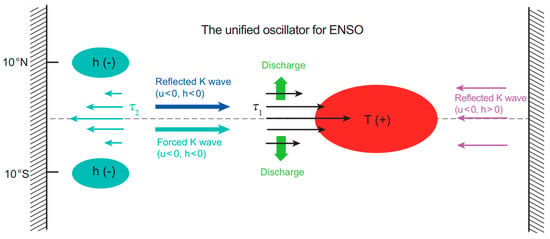
Figure 3.
Schematic diagram of the unified oscillator. , , , and are four variables that represent the SST anomalies in the equatorial eastern Pacific, the thermocline depth anomalies in the off-equatorial western Pacific, the zonal wind stress anomalies in the equatorial central Pacific, and the zonal wind stress anomalies in the equatorial western Pacific, respectively. From [43], Figure 5, with kind permission Copyright 2022 from the Oxford University Press on behalf of China Science Publishing & Media Ltd.
2.2.2. The Role of Coupled Baroclinic Waves in the Genesis of ENSO
In trying to understand the characteristics of SSH signatures of what are called tropical instability waves, it has been shown that they are formed from a resonance between two equatorial Rossby waves as the strength of the background currents is slowly increased [60]. The coupling of two systems formed of oceanic planetary waves plays a key role of in the genesis of ENSO: the tropical Pacific is subject to two quasi-stationary baroclinic wave systems, an annual Rossby wave forced by easterlies (Figure 4), and a quadrennial QSW coupled with the annual wave (Figure 5) [13,24].
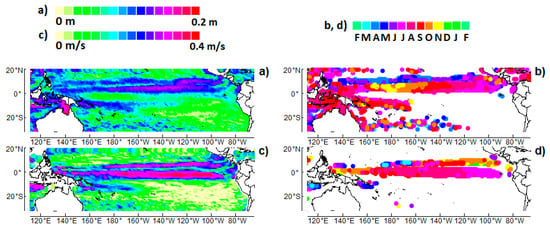
Figure 4.
(a,b) Amplitude and phase of SSH anomalies; (c,d) velocity and phase of zonal geostrophic currents (faces east when phase is zero). Amplitude and phase are averaged over the 8–16 month band (years 1999–2000). From [13], Figure 1, with kind permission Copyright 2022 from Pure and Applied Geophysics.
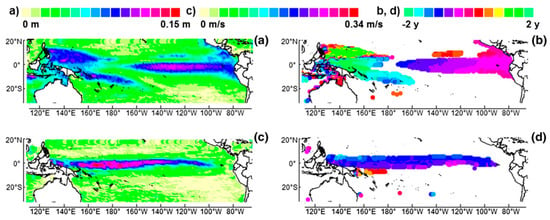
Figure 5.
(a,b) Amplitude and phase of SSH anomalies; (c,d) velocity and phase of zonal geostrophic currents (faces east when phase is zero). The amplitude and the phase are averaged over the 1.5–7 year band (years 1994–2001). The phase is relative to the maturation phase of El Niño (at a minimum of the Southern Oscillation Index SOI) that occurred in 11/1997. From [13], Figure 9, with kind permission Copyright 2022 from Pure and Applied Geophysics.
SSH anomalies resulting from the annual wave are represented in Figure 4a,b, exhibiting two long-crested waves between latitudes 0° N and 12° N, almost in opposite phases. They extend from the eastern coasts of Southeast Asia to Central America. Two modulated zonal geostrophic currents flowing north and south of the equator, i.e., between 4.5° N and 7.5° N, merging with the North Equatorial Countercurrent (NECC), and between 0° N and 4.5° S, merging with the SEC, are displayed in Figure 4c,d.
Observations of SSH anomalies and surface current velocities suggest that the annual QSW is a first baroclinic, fourth-meridional mode Rossby wave resonantly forced by easterlies. Only the stimulation of a high meridional mode Rossby wave can explain the strip structure of the wave and the two nodes, whose analysis reveals that they are only one, being highly correlated. Seasonal zonal velocity anomalies of jets at 1000 m are observed to propagate westward across the basin (Figure 6a); they are consistent with annual vertically propagating Rossby waves superimposed on the mean zonal jets. Their meridional structure suggests that higher meridional modes are present at depth [61]. Figure 6b,c confirm that the amplitude of the jets is stronger in the southern hemisphere and the western part of the northern tropical Pacific.
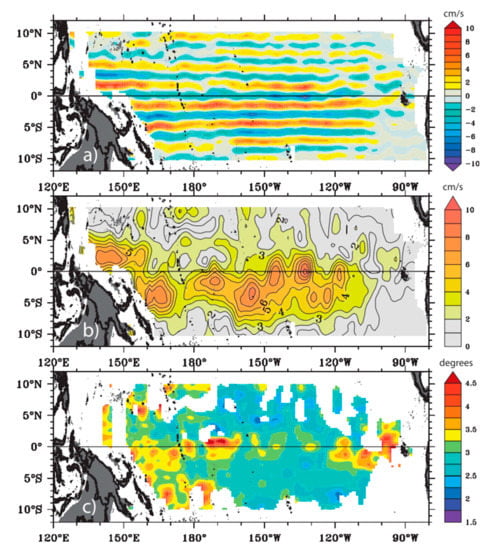
Figure 6.
Zonal jets in the Tropical Pacific Ocean observed by Argo Floats at 1000 m depth: (a) zonal annual currents (cm/s), (b) meridional currents (cm/s), and (c) local meridional wavelength (degrees of latitude). Topography shallower than 1000 m depth is shaded in dark gray. From [61], Figure 4, with kind permission Copyright 2022 from Journal of Physical Oceanography.
The quadrennial wave results from a westward propagating Rossby wave, trapped by the equator and deflected as off-equatorial Rossby waves embedded in the NECC in its western part, as well as an eastward propagating Kelvin wave, trapped by the equator, which results from the reflection of the off-equatorial Rossby waves when the NECC vanishes or changes direction. Both QSWs are coupled because they share the same node, the SEC.
The annual equatorial Rossby wave induced by easterly trade wind anomalies, which turns out to be a fourth-meridional mode Rossby wave, facilitates the heat content buildup in the western part of the tropical Pacific [1]. El Niño occurs during the eastward propagation phase of the quadrennial wave when the reflected Kelvin waves lead to positive SST anomalies in the CP or EP region and create an El Niño event. The type of event depends on the mode of interaction between the annual and quadrennial waves. This is reflected by the lag of ENSO (Figure 7), which is deduced from the date of occurrence compared to the central value of 4-year intervals of January 1992 to January 1996, January 1996 to January 2000, etc. [62,63]. CP events always occur while the El Niño peaks out of phase with the annual quasi-stationary wave (segments in red in Figure 7, no event can occur in the black segment). EP events occur while the El Niño peaks in phase with the annual quasi-stationary wave (green, dark, and light blue segments).

Figure 7.
The time lags (in years) within the four-year cycle. In red, the El Niño–Southern Oscillation (ENSO) event is out of phase with the annual quasi-stationary wave; in green, it is unlagged; in light blue, it is weakly lagged; and in dark blue, it is strongly lagged. Black segment represents the forbidden lag (no event can occur). From [63], Figure 3, with kind permission Copyright 2022 from Journal of Marine Science and Engineering (JMSE).
El Niño events in phase with the annual QSW (EP events) are represented in Figure 8. The phase of the main SST anomaly is behind the maturation stage of the unlagged event (Figure 8a). It is nearly concomitant with the maturation stage of lagged events (Figure 8b–d).
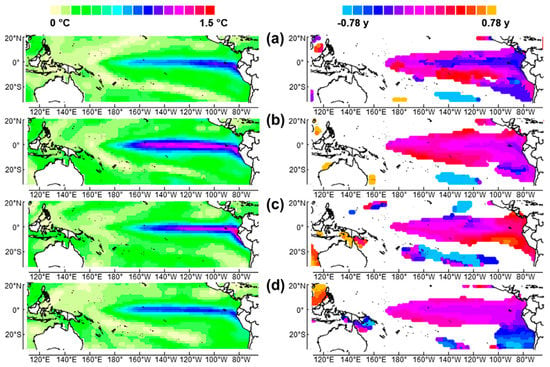
Figure 8.
Amplitude (left) and phase (right) of SST anomalies in the 1.5–7 year band. The phase is relative to EP El Niño events that are mature in 08/1969 (a), in 09/1972 (b), in 12/1982 (c), and in 10/1963 (d). Those events are in phase with the annual QSW. The first event is unlagged (–0.42 years), the second and the third are weakly lagged (–1.33 and 0.92 years, respectively), and the last is strongly lagged (1.75 years). From [62], Figure 2, with kind permission Copyright 2022 from Geophysical & Astrophysical Fluid Dynamics.
In Figure 9, El Niño events out of phase with the annual QSW (CP events) exhibit a significant contribution of the SST anomaly between latitudes 5° N and 20° N in the central Pacific, resulting from the northern antinode of the annual QSW. The event in Figure 9b is well characterized because the SST anomaly forms simultaneously in the central and eastern Pacific, about 6 months before the ENSO maturation phase. In Figure 9a, the central SST anomaly occurs during the maturation phase of ENSO while the eastern anomaly is 6 months ahead, or even more off the coast of Chile. This highlights a combined effect of the central and eastern tropical Pacific.
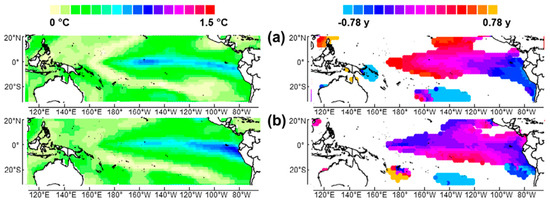
Figure 9.
Same representation as in Figure 2 for CP events out of phase with the annual QSW. The maturation occurs in 03/1941 (a) and in 03/1919 (b). The lag of the first event is negative (–0.83 years) and that of the second is positive (1.14 years). From [62], Figure 3, with kind permission Copyright 2022 from Geophysical & Astrophysical Fluid Dynamics.
Figure 8 and Figure 9 represent the SST anomalies observed during the maturation of some ENSO events, which account for their variability in terms of the amplitude of the anomaly and its phase. This indicates how the anomaly develops in relation to ENSO maturation.
The average period of the quadrennial wave is 4 years, which corresponds to a subharmonic mode of the annual period, with significant variability, between 1.5 and 7 years. This is attributable to the mode of forcing of the quadrennial wave, which results both from the coupling with the annual wave, but also from El Niño, which promotes convective and evaporative processes when the warm waters from the Western Pacific meet the cold waters of the eastern tropical Pacific. Upwelling of the thermocline accompanies the quadrennial wave during its westward propagation phase, which terminates ENSO. The role played by the geostrophic forces during the westward recession of the quadrennial QSW when La Niña occurs is therefore added to the arguments invoked in the delayed oscillator model.
In this way, the quadrennial wave is partly self-sustained, which results from the geostrophic forces at the Tropical Pacific Basin scale under the influence of evaporative processes that are stimulated in the eastern tropical Pacific when ENSO is maturing. ENSO occurrence can then be explained by two views: (i) a self-sustained oscillatory mode (the quadrennial QSW) and (ii) a stable mode interacting with high-frequency forcing, such as westerly wind bursts and Madden–Julian Oscillation events (the annual QSW).
2.2.3. The Climate Impact of ENSO
The climate impacts of El Niño are schematically represented in Figure 10 and La Niña in Figure 11. Climate pattern oscillations resulting from ENSO may cause extreme weather such as floods and droughts in many regions of the world, particularly those bordering the Pacific Ocean. The tropical Pacific SST anomalies impact extratropical climate variability through stationary atmospheric waves and their interactions with mid-latitude storm tracks [1]. In a transfer of warm waters occurring from the west of the tropical Pacific to the east, taking the rain with it, the regions most affected are Indonesia and northern South America, which experience episodes of drought, while intense rainfall occurs in southeastern South America, eastern equatorial Africa, and the southern United States.

Figure 10.
Climate impact of El Niño in December to February (left) and June to August (right). Source: National Oceanic and Atmospheric Administration (NOAA).

Figure 11.
Climate impact of La Niña in December to February (left) and June to August (right). Source: National Oceanic and Atmospheric Administration (NOAA).
The Western Pacific Basin experiences a change in the location of where tropical cyclones form. Consequently, Micronesia is more affected by tropical cyclones, while China is spared [64]. A similar phenomenon occurs in the southern Pacific between 135° E and 120° W, with tropical cyclones more likely to occur within the Southern Pacific Basin than the Australian region.
ENSO linkages exist in Antarctica [65]. Specifically, reduced sea ice and increased poleward heat fluxes occur over the Amundsen and Bellingshausen Seas, as well as the Ross Sea, whereas the Weddell Sea experiences more sea ice during El Niño. The opposite occurs during La Niña [66]. This pattern of variability is known as the Antarctic dipole mode.
EP and CP events may have different El Niño as well as La Niña effects because different teleconnections affect the global climate [63,67,68,69,70]. In the tropics, heat transfer from the Pacific Ocean to the atmosphere produces quasi-geostrophic motion of the atmosphere [16]. From the heating zone, equatorial-trapped eastward Kelvin waves and westward Rossby waves are formed.
In Figure 12, the impact of EP and CP events is evidenced from the variability of precipitation height. To eliminate the seasonal variability, the raw daily data (averaged over a month) of the ENSO-influenced precipitation are averaged over annual periods framing the ENSO maturation phase. According to Figure 7, three types of events can be characterized by the lag according to whether they are (1) unlagged or weakly lagged EP events, (2) strongly lagged EP events, or (3) out of phase with the annual QSW CP events.
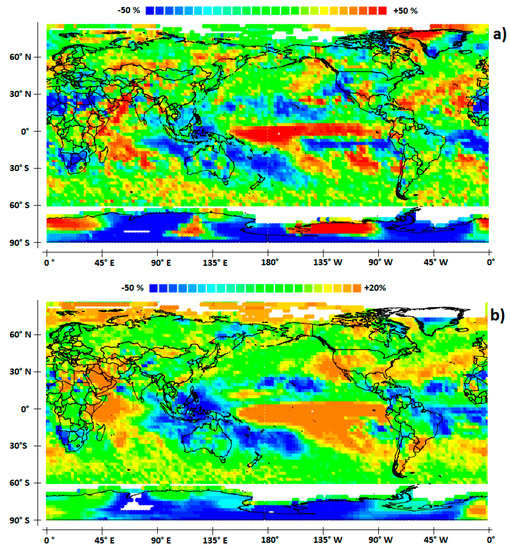
Figure 12.
Impact of the ENSO from the variability of precipitation height (the deviation is expressed in % compared to the average precipitation). (a) ENSO events out of phase with the annual QSW are considered CP events. (b) Unlagged and weakly lagged events are considered EP events. From [63], Figures 7 and 8, with kind permission Copyright 2022 from Journal of Marine Science and Engineering (JMSE).
In Figure 12a, two significant CP events are considered (type 3), which occurred in May 1987 and December 2006. In Figure 12b, five significant EP events are considered (type 1), which occurred in December 1982, September 1994, November 1997, December 2002, and November 2009. The comparison of Figure 12a,b shows that the ENSO-induced precipitation band along the equator is both narrower and more intense in the case of CP events. On the other hand, it seems that the thermal anomaly in the center of the tropical Pacific favors distant teleconnections, which result in a drop in precipitation in West Africa.
Due to the 8-year period subharmonic of the quadrennial QSW, warm (cold) SST anomalies in the tropical Pacific induce an anomalous cyclonic (anticyclonic) circulation in the South Pacific, which is tilted in a southeast–northwest direction [71,72]. This tends to slowly discharge/recharge the tropical ocean on the decadal timescale.
2.3. The Indian Ocean
2.3.1. Tropical Rossby Waves
The Indian Ocean has a particularity—its width is close to half the wavelength of a Rossby wave of biannual frequency, that is, 6300 km from the east coast of Africa to the west coast of Sumatra. Two independent basin modes resonantly forced are highlighted: (1) a nearly symmetric zonal 1/2-year period QSW that is resonantly forced by the biannual monsoon, which controls the Equatorial Counter Current at the node [24,73,74,75,76,77,78,79] (Figure 13), emphasizing that the first-baroclinic-mode is subject to a half-wave resonance [80,81,82], and (2) a 1-year period QSW formed from an off-equatorial Rossby wave, propagating in the southern and northern hemispheres. It is induced from the Indonesian Throughflow through the Timor passage. The forcing results from easterlies in the southern hemisphere and monsoon wind in the northern hemisphere. The annual variability has been investigated by [83,84,85].
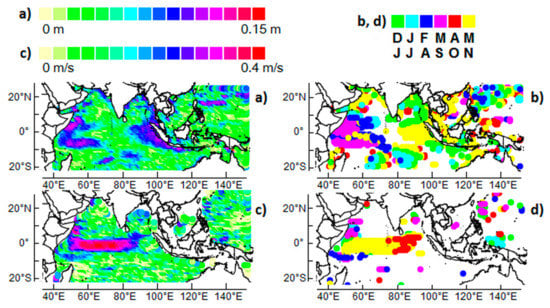
Figure 13.
Amplitude (left) and phase (right) in 2004, averaged over the 5–7 month band of (a,b) SSH anomalies (the antinodes of the QSW); (c,d) velocity U (faces east when phase is zero) of the modulated geostrophic currents (the nodes of the QSW). From [14], Figures 1 and 8, with kind permission Copyright 2022 from Dynamics of Atmospheres and Oceans.
2.3.2. The Indian Ocean Dipole (IOD)
The IOD phenomenon was first identified in 1999 [86,87]. It results from the coupling of several baroclinic modes [14]. During the IOD that develops from April to November, the western Indian Ocean becomes alternately warmer (positive phase) and then colder (negative phase) than the eastern part of the ocean. A positive IOD is associated with droughts in Southeast Asia and Australia, and high rainfall over the East Africa region.
The link between ENSO and IOD has been studied to explain the variability of the tropical Indian Ocean [88,89,90,91]. IODs with a peak in fall are categorized into three types [92]. The first type is closely related to the development phase of El Niño/La Niña. The second type evolves from the basin-wide warming (cooling) in the tropical Indian Ocean, usually occurring in the year following El Niño (La Niña). The third type is independent of El Niño and La Niña: the dominant trigger condition is the anomalous cross-equatorial wind flow (Figure 14).
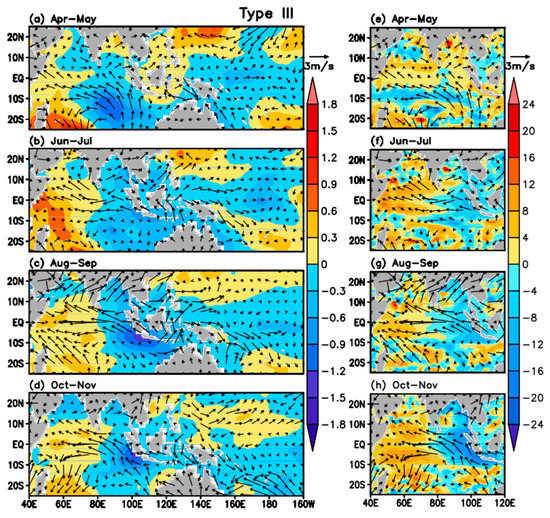
Figure 14.
Bimonthly mean of (left) SST anomalies (shaded, °C) and surface wind anomalies (vectors, m/s) and (right) sea surface height anomalies (shaded, cm) and surface wind anomalies (vectors, m/s) for the third type of IOD that occurred in 1961. From [92], Figure 6, with kind permission Copyright 2022 from Journal of Climate.
Extreme IOD events may occur, such as what happened in fall 2019 [93]. Westward propagating oceanic Rossby waves led to anomalous SST anomalies in the southwest tropical Indian Ocean, inducing deep convection and anomalous easterly winds along the equator. This Bjerknes feedback involved equatorial ocean advection until the maturation phase. In early summer 2020, the Meiyu–Baiu season of rainfall was markedly enhanced, triggering devastating floods in Japan and central China [94]. The Indian Ocean warmth was influenced by strong downwelling Rossby waves, SST anomalies in the tropical western Pacific, and associated modulation of monsoon flow.
2.3.3. The Madden–Julian Oscillation (MJO)
The Madden–Julian oscillation (MJO) is a traveling pattern that propagates eastward, at approximately 4 to 8 m/s, through the atmosphere above the warm parts of the Indian and Pacific oceans [95,96] (Figure 15). The MJO is the main intraseasonal fluctuation in tropical weather, modulating precipitation, pressure, and winds all year. Although MJO was discovered in 1971 by Roland Madden and Paul Julian, several decades were needed to better understand the interactions between the ocean and the atmosphere at the origin of the phenomenon [97,98,99]. Studies have indicated that Rossby waves can affect the large-scale flow in important ways [100].
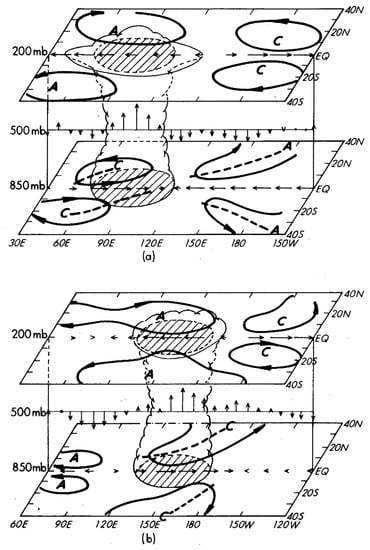
Figure 15.
Schematic representation of the characteristic structure of the intraseasonal low-frequency atmospheric waves. The zonal wind and vertical velocity anomalies in the equatorial zonal plane are represented during the eastward-propagating Madden–Julian event (a,b). From [96], Figure 8, with kind permission Copyright 2022 from Journal of Atmospheric Sciences.
Although MJO does not appear to result from resonant forcing of Rossby and Kelvin waves per se, the mechanisms involve positive feedback between oceanic Rossby waves and atmospheric waves. However, the displacement of SST anomalies is in phase with the horizontal advection of the atmospheric wave, but the baroclinic ocean waves involved in the forcing do not appear to form a coherent dynamical system, unlike ENSO.
The remote ocean response to unique MJO events was investigated during the CINDY/DYNAMO field campaign in 2011–2012 [101,102]. Anomalous SSH associated with the strong eastward jets propagate eastward as an equatorial Kelvin wave. The positive SSH anomalies then partly propagate westward as a reflected Rossby wave. These studies have indicated the significant influence of reflected Rossby waves with which a wide wavelength spectrum is associated [103].
The formation of the cyclone Chapala in November 2015 was triggered by the arrival of eastward-propagating atmospheric convection associated with the MJO. The generation of the second Cyclone Megh within 8 days appears to be associated with the oceanic Rossby wave that led to an increase in the upper ocean heat content [104].
3. Mid-Latitudes
The first observations of Rossby waves propagating along subtropical gyres go back several decades, as soon as altimeter data were available at the beginning of the 1990s. Rossby waves have been discovered along the five subtropical gyres, particularly after the western boundary currents leave the continents to re-enter the gyres. Although most studies focus on annual and semi-annual waves, the band of periods concerned is very wide since it extends from a few days to several million years. The lower limit is imposed by the Rossby radius of deformation, which is the length scale at which rotational effects become as important as buoyancy or gravity wave effects in the evolution of the flow about some disturbance. In the ocean, the Rossby radius varies from 200 km near the equator to 10 km at high latitudes. At mid-latitudes, it is a few tens of kilometers, which corresponds to a period of a few days if a speed of 3 cm s−1 is assumed (≈0.1 km/h).
On the other hand, very-long-period Rossby wavelength has no upper limit. With the associated modulated geostrophic current being non-divergent in the equations of motion, multiple turns may overlap around the subtropical gyre. This is because the duration of forcing of the mixed layer around the gyre during half a period compensates for wave damping due to the Rayleigh friction as the period increases, both being proportional to the period but with antagonistic effects [105].
3.1. The Band of Periods from a Few Days to a Year
3.1.1. Annual and Semiannual Rossby Waves
Among the very first observations from satellite altimeter data, Rossby waves of 2–3 cm amplitude, propagating westward at 3 cm s−1 with a wavelength of about 500 km, were documented in the South Atlantic subtropical gyre between 15° and 35° S [106]. The large-scale variability showed a significant semiannual component in phase with climatological winds.
Annual Rossby waves were studied in the southern Indian Ocean from 19° to 9° S [107]. The westward phase propagation of the annual variability appears to break up in the mid-ocean, which results from the destructive interference between the Rossby waves and the localized response. The annual variability appears to be mainly driven by wind forcing. Another study focuses on the annual cycle of circulation in the western boundary current system of the southwest Pacific Ocean, where the annual wind stress curl over the South Pacific produces a large region of uniformly phased, stationary thermocline depth anomalies near 10° S [108]. From [109], large fluctuations in SSH in the southwest Pacific between New Zealand and Fiji result from steric heating and wind-driven Rossby waves, which explains more than 40% of the observed SSH variance.
Using Argo float data to detect signatures of long Rossby waves in the velocity of the currents and temperature at 1000 m depth in the zonal band of 4–24° N in the tropical North Atlantic, long Rossby waves (wavelength between 1000 and 2500 km) were investigated in the west and east of the Mid-Atlantic Ridge (MAR) sub-basins [110]. This study specifies how Rossby waves are generated from topographic discontinuities.
3.1.2. Resonant Forcing
From [111], the Fourier spectrum of sea level anomalies (SLA) located on the north Atlantic gyre highlights an annual fundamental wave, the amplitude of which is predominant. This gives rise to harmonics whose main periods are 1/3-year, 1/6-year, 1/12-year, and 1/24-year. These observations, which seem to be verified in other subtropical gyres, show that the main driver of Rossby waves at mid-latitudes is the variation in solar irradiance due to the declination of the sun. Indeed, as shown by most of the works cited above, wind stress explains only part of the variance of the SLA observed. Moreover, the presence of harmonics suggests that the forcing is resonant according to the model of the Caldirola–Kanai oscillator.
In Figure 16, Rossby waves are highlighted from the SLA, the zonal geostrophic current U, and the meridional current V in the northwestern Atlantic. The period approaches the lower limit set by the Rossby radius of deformation. Rossby waves form a mosaic of convergent or divergent cells depending on whether the resulting geostrophic currents U and V converge or diverge within these cells that extend longitudinally over an apparent half wavelength. The uplift of the thermocline that occurs in divergent cells enhances upward convection and evaporation from the ocean surface, while the lowering of the thermocline that occurs in convergent cells causes them to behave as heat sinks.
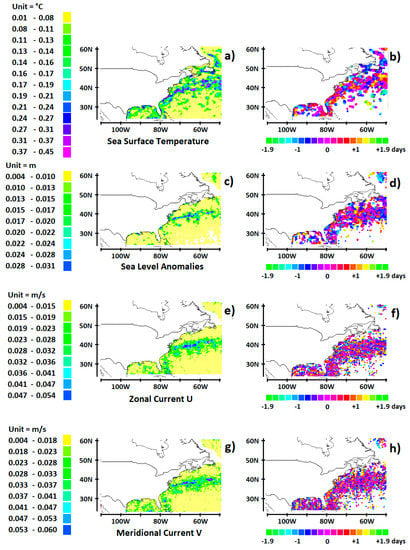
Figure 16.
The amplitude (a,c,e,g) and the phase (b,d,f,h) of SST, SLA, the zonal geostrophic current U, and the meridional current V in the northwestern Atlantic. The amplitude and phase are represented in the period band 2.9–5.7 days (i.e., the frequency band 64–128 cycles/year) with an average period of 3.8 years (i.e., an average frequency of 96 cycles/year). The phase is the time lag relative to 6 February 2020. At the origin of the phase, SST anomalies are positive, SLA anomalies are negative, the zonal current anomalies face east, and the meridional current anomalies face south. (Original figure).
As shown by the SST anomalies, these observations suggest the strong ocean–atmosphere interaction occurring along the western portion of the subtropical gyres according to a wide spectrum of time scale. The most active cells have a period of 1/6 or 1/12 years. This suggests that this is the maturation time necessary for a vertical temperature profile to tend towards an equilibrium. The phase of SST anomalies then tends to synchronize between the cells, which results from feedbacks between the ocean and the atmosphere. During this brief maturation phase, the coupling between the ocean and the atmosphere is optimal, as is the impact of the ocean on the climate. This research opens up new perspectives for the forecasting of extreme events, whether exceptional precipitation in terms of intensity and duration, or heatwaves, in case SST anomalies are involved.
3.2. Decadal Variability
At mid-latitudes, few studies have established the driving role of oceanic Rossby waves in the decadal climate variability. However, the Rossby waves that develop along subtropical gyres have a significant climatic impact since they are the driver of the rainfall oscillation in the 5–10-year band [112,113]. The succession of wet or dry years can indeed produce floods or, conversely, droughts with a significant societal impact.
The rainfall oscillation results from baroclinic instabilities of the atmosphere over the subtropical gyres induced by positive or negative SST anomalies. They are produced by 8-year-period Rossby waves that are subharmonics of the annual fundamental Rossby wave. Baroclinic instabilities of the atmosphere are most active when the resulting systems of high or low pressure are stimulated and guided by the polar or subtropical jet streams (Figure 17). This research opens up new perspectives for predicting interannual climate variability in impacted regions, whether wet or dry cycles with significant societal impacts. Over the same regions, the rainfall oscillation is also generated by 4-year-period Rossby waves, but this phenomenon can hardly be differentiated from ENSO.
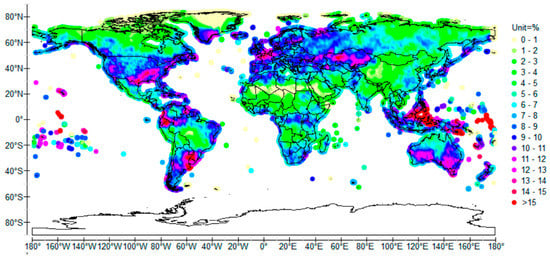
Figure 17.
Variations in relative rainfall height in the 5–10-year band. From [113], Figure 2, with kind permission Copyright 2022 from Climate.
3.3. Multidecadal Variability
From [114], mechanisms for Pacific interdecadal resonances result from both atmospheric and oceanic teleconnections between the extratropics and tropics. The nature of resonant peaks observed are described by a delayed oscillator model. The effect of a finite ocean depth on the upper ocean baroclinic instability is examined in [115] using a quasi-geostrophic three-layer model: instabilities are a consequence of the resonant interplay between the stable modes and a short Rossby wave in the deep layer.
More prospectively, among the multidecadal variations of the climate, the Atlantic Multidecadal Oscillation (AMO) is linked to the 64-year-period Rossby wave winding around the North Atlantic gyre, i.e., a subharmonic of the 8-year-period Rossby wave Figure 18 [105]. AMO is nearly in phase with the sunspot number (SSN). This research opens up new perspectives for a better understanding of the origin of cycles whose period is multidecadal, as well as their climatic impact.

Figure 18.
(a) De-trended AMO unfiltered and filtered with a bandpass filter within the 48–96 year band; (b) Fourier power spectrum of AMO from 1856 to 2016; (c) SSN unfiltered and filtered with the same bandpass filter as in (a). From [105], Figure 7, with kind permission Copyright 2022 from Journal of Marine Science and Engineering (JMSE).
The resonance of gyral Rossby waves is indeed based on a new concept, that according to which Rossby waves at mid-latitudes are mainly forced by the variation in solar irradiance due to the declination of the sun. The annual fundamental wave produces harmonics and subharmonics. These are also forced by the solar and orbital cycles. Some climatic cycles such as AMO disclose their origin since the Fourier spectrum applied to a long time series of observation displays a well-defined peak close to the period of a subharmonic mode. In this specific case, the ocean–atmosphere interactions reflect the SST anomalies around the gyres.
3.4. Orbital Forcing
An almost unexplored area of research concerns a better understanding of the role of Rossby waves in the mechanism of orbital forcing of the climate system. Pioneering work has recently been carried out in this direction and suggests promising prospects including, for example, the origin of MPT, or the ocean circulation subject to the functioning of subtropical gyres [18,19]. Based on the non-dispersivity of very-long-period Rossby waves and their ability not to be damped when the period increases, the momentum equations, the equation of continuity, and the equation of conservation of the potential vorticity can be transposed to subtropical gyres by replacing the β-plane approximation with a β-cone approximation (Appendix B).
It then appears that these so-called “gyral” Rossby waves are endowed with astonishing properties. Winding around subtropical gyres, their existence no longer results from the variation in the Coriolis parameter with latitude but according to the mean radius of the gyres. Applying the model of the Caldirola–Kanai oscillator to the coupled multifrequency Rossby waves, it appears that they are resonantly forced in subharmonic modes from variations in solar irradiance resulting from the solar and orbital cycles. Since gyral Rossby waves are supposed to strongly impact the climate system, these subharmonic modes have been specified from the observation of climate archives while using the variations in solar irradiance calculated from the orbital parameters for the past million years [19].
This prospective work made it possible to establish a resonance at years for the North and South Atlantic gyres as well as the South Indian gyre, and at years for the North and South Pacific gyres since MPT (Appendix A). In addition to AMO, the concept of gyral Rossby waves provides a straightforward explanation of the climate transition in which the duration of glacial–interglacial cycles increased from 41 ka to 98 ka about 1.2 million years ago [116]. The period of eccentricity then approached the natural period of the subharmonic mode (i.e., the number of turns of the gyral Rossby wave around the north Atlantic gyre), namely, Ka, and remained unchanged until now (Figure 19). Before MPT, the forcing period was 41 Ka, coherent with the obliquity whose amplitude of variation is much higher than that of the eccentricity. As evidenced by the observation of marine sediment cores, the subtropical gyres were smaller before the MPT. The first subharmonic mode was probably instead of . Consequently, the resonant subharmonic mode was so that the natural period was Ka instead of Ka. The difference between the natural period of the gyres and the period of the forcing could be reduced by means of a latitudinal translation of their centroids by 2° towards the equator, which made it possible to increase the phase velocity by 10% from the dispersion relation (A11).
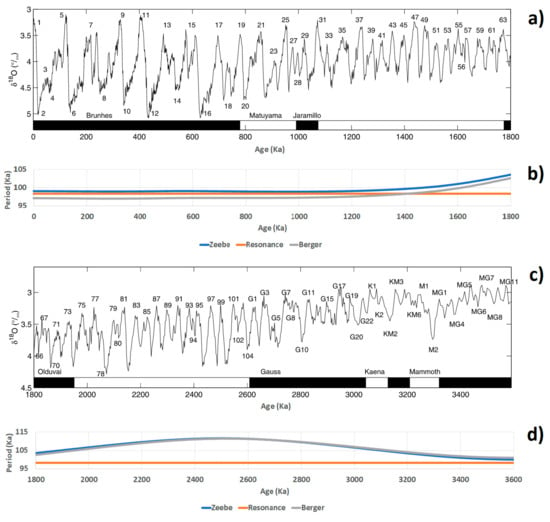
Figure 19.
Glacial–interglacial cycles and the period of eccentricity. (a,c) The LR04 benthic stack constructed by the graphic correlation of 57 globally distributed benthic records. (b,d) The period of eccentricity from Berger, 1991 [117], and Zeebe, 2019 [118], and the period of resonance [19]. From [116], Figure 4, with kind permission Copyright 2022 from Paleoceanography.
Funding
This research received no external funding.
Institutional Review Board Statement
The study did not require ethical approval.
Informed Consent Statement
Not applicable.
Data Availability Statement
Only public data duly referenced are used in the present study.
Acknowledgments
The author warmly thanks the reviewers for their help and dedication.
Conflicts of Interest
The author declares no conflict of interest.
Abbreviations
| AMO | Atlantic Multidecadal Oscillation |
| CP | Central Pacific El Niño |
| ENSO | El Niño–Southern Oscillation |
| EP | Eastern Pacific El Niño |
| IOD | Indian Ocean Dipole |
| ITCZ | Inter Tropical Convergence Zone |
| MAR | Mid-Atlantic Ridge |
| MJO | Madden–Julian oscillation |
| MPT | Mid-Pleistocene Transition |
| NEC | North Equatorial Current |
| NECC | North Equatorial Counter Current |
| QSW | Quasi-Stationary Wave |
| SEC | South Equatorial Current |
| SLA | Sea Level Anomalies |
| SOI | Southern Oscillation Index |
| SSH | Sea Surface Height |
| SSN | Sunspot Number |
| SST | Sea Surface Temperature |
Appendix A. Prototype of Coupled Oscillator Systems
Subharmonic modes of coupled oscillator systems may be derived only by considering the conditions of durability of the dynamical system. For this, consider the system of Caldirola–Kanai equations governing the motion for a system of coupled oscillators corresponding to the resonance frequencies:
where represents the phase of the ith oscillator (proportional to the modulated geostrophic polar current around the gyre), the inertia parameter, i.e., the mass of water displaced during a cycle resulting from the quasi-geostrophic motion of the ith oscillator, the damping parameter referring to the Rayleigh friction and measures the coupling strength between the oscillators and . The right-hand side describes the periodic driving on the oscillator with frequency and amplitude , which represents both forcing and geostrophic forces, that is, Coriolis and pressure gradient forces. The restoring force simply depends on the phase difference between the oscillators. So, it vanishes when the phases are equal witch, in the absence of friction, removes any interaction between the oscillators and . On the other hand, the interaction is all the stronger as the difference in polar velocities is higher.
This model is both simple and very general since it applies to all quasi-stationary and multi-frequency planetary waves having a common node, as occurs both in tropical oceans and at mid-latitudes. The interaction energy of the oscillator is [17]:
It is from this relationship that a necessary and sufficient condition to ensure the durability of the resonant oscillatory system is established: the coupled oscillators form oscillatory subsystems so that the resonance conditions are to be defined recursively:
where or 3. T is the period of the fundamental wave (generally one year).
Appendix B. The β-Cone Approximation
The β-cone approximation [105] is intended to replace the β-plane approximation for expressing the equations of motion of long-period Rossby waves that propagate over a significant range of latitudes around the subtropical gyres. A cone of revolution tangent to the terrestrial sphere whose axis passes through the centroid of the gyre defines a circle C at the contact; the apex angle θ is defined so that the radius of C equals the average radius of the gyre (Figure A1).
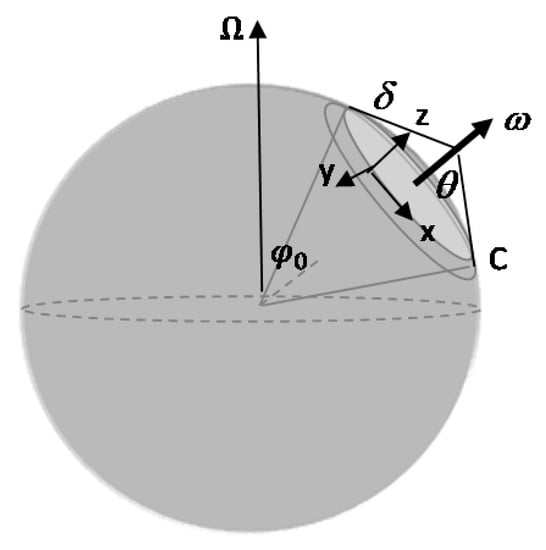
Figure A1.
The β-cone approximation. From [105], Figure 1, with kind permission Copyright 2022 from Journal of Marine Science and Engineering (JMSE).
Consider an orthogonal system of reference delineating the circle C with the x-axis tangent to C, the y-axis tangent to the sphere, and the vertical z-axis. In conical coordinates:
where δ is the distance to the apex of the cone and φ is the polar coordinate. This system is rotated about the axis , i.e., the projection of the vector of rotation of the Earth on the axis of the cone, with uniform angular velocity ; , where is the latitude of the center of C. is the Coriolis vector at the center of C ( is the Coriolis parameter). Around C, the Coriolis vector tends asymptotically to as the radius r decreases. So, when the radius r of C is small compared to the radius R of the Earth , the Coriolis vector can be considered constant around C so that . It is under these conditions that the β-cone approximation applies optimally because it remains valid for large δ variations due to the proximity of the cone and the sphere.
x = δ sin θ cos φ, y = δ sin θ sin φ, z = δ cos θ
The momentum equation for a material element located on C in the upper layer of two superposed fluids whose density is and depth is [16]:
where is the pressure gradient, is the velocity vector , and u and v are the polar and radial current velocities, respectively.
Using the polar coordinate and the radial coordinate δ on C, the momentum equations are:
where η is the vertical perturbation of the surface height and g is the acceleration of gravity. X and Y are the surface stress forcing terms relative to and δ.
The equation of continuity on the surface of the cone is:
where E is the evaporation rate. div . In the vicinity of C:
The equation of conservation of the relative vorticity is:
where is the absolute vorticity.
The relative vorticity ξ ≈ − is the component of the curl of velocity (curl ) perpendicular to the surface of the cone at the considered location.
So, in the vicinity of C.
Expanding f versus δ: , the equations of motion A6–A10 along convex paths close to C on the β-cone (, δ) are virtually the same as those expressed on the β-plane (longitude, latitude) . In the first case, the variational calculation is applied to the mean radius of the gyre. In the second case, it is applied to the latitude.
The phase velocity is given by the following dispersion relation:
where c is the phase velocity along the equator for the first baroclinic mode and is the latitude of the center of C.
References
- Farneti, R. Coupled Interannual Rossby Waves in a Quasi-geostrophic Ocean–Atmosphere Model. J. Phys. Oceanogr. 2007, 37, 1192–1214. [Google Scholar] [CrossRef][Green Version]
- Liu, Z.; Alexander, M. Atmospheric bridge, oceanic tunnel, and global climatic teleconnections. Rev. Geophys. 2007, 45, 1–34. [Google Scholar] [CrossRef]
- Cessi, P.; Louazel, S. Decadal Oceanic Response to Stochastic Wind Forcing. J. Phys. Oceanogr. 2001, 31, 3020–3029. [Google Scholar] [CrossRef]
- Liu, Z. How long is the memory of tropical ocean dynamics? J. Clim. 2002, 15, 3518–3522. [Google Scholar] [CrossRef]
- Liu, Z. Tropical Ocean Decadal Variability and Resonance of Planetary Wave Basin Modes. Part I: Theory. J. Clim. 2003, 16, 1539–1550. [Google Scholar] [CrossRef]
- Chelton, D.B.; Schlax, M.G. Global Observations of Oceanic Rossby Waves. Science 1996, 272, 234–238. [Google Scholar] [CrossRef]
- Sverdrup, H.U. Wind-Driven Currents in a Baroclinic Ocean; with Application to the Equatorial Currents of the Eastern Pacific. Proc. Natl. Acad. Sci. USA 1947, 33, 318–326. [Google Scholar] [CrossRef] [PubMed]
- Stommel, H.; Arons, A.B. On the abyssal circulation of the world ocean—I. Stationary planetary flow patterns on a sphere. Deep Sea Res. 1960, 6, 140–154. [Google Scholar] [CrossRef]
- Stommel, H.; Yoshida, K. Kuroshio: Its Physical Aspects; University of Tokyo Press: Tokyo, Japan, 1972. [Google Scholar]
- Hall, M.M.; Bryden, H.L. Direct estimates and mechanisms of ocean heat transport. Deep Sea Res. Part. A Oceanogr. Res. Pap. 1982, 29, 339–359. [Google Scholar] [CrossRef]
- Bryden, H.L.; Roemmich, D.H.; Church, J.A. Ocean heat transport across 24° N in the Pacific. Deep Sea Res. Part. A Oceanogr. Res. Pap. 1991, 38, 297–324. [Google Scholar] [CrossRef]
- Pinault, J.-L. Long Wave Resonance in Tropical Oceans and Implications on Climate: The Atlantic Ocean. Pure Appl. Geophys. 2013, 170, 1913–1930. [Google Scholar] [CrossRef]
- Pinault, J.-L. Long Wave Resonance in Tropical Oceans and Implications on Climate: The Pacific Ocean. Pure Appl. Geophys. 2015, 173, 2119–2145. [Google Scholar] [CrossRef]
- Pinault, J.-L. Resonance of baroclinic waves in the tropical oceans: The Indian Ocean and the far western Pacific. Dyn. Atmos. Oceans 2020, 89, 101119. [Google Scholar] [CrossRef]
- McCreary, J.P.; Lukas, R. The response of the equatorial ocean to a moving wind field. J. Geophys. Res. Earth Surf. 1986, 91, 11691–11705. [Google Scholar] [CrossRef]
- Gill, A.E. Atmosphere-Ocean Dynamics; International Geophysics Series; Academic Press: Cambridge, MA, USA, 1982; 662p. [Google Scholar]
- Choi, M.Y.; Thouless, D.J. Topological interpretation of subharmonic mode locking in coupled oscillators with inertia. Phys. Rev. B 2001, 64, 014305. [Google Scholar] [CrossRef]
- Pinault, J.-L. Resonantly Forced Baroclinic Waves in the Oceans: Subharmonic Modes. J. Mar. Sci. Eng. 2018, 6, 78. [Google Scholar] [CrossRef]
- Pinault, J.-L. Resonantly Forced Baroclinic Waves in the Oceans: A New Approach to Climate Variability. J. Mar. Sci. Eng. 2020, 9, 13. [Google Scholar] [CrossRef]
- Zaqarashvili, T.V.; Albekioni, M.; Ballester, J.L.; Bekki, Y.; Biancofiore, L.; Birch, A.C.; Dikpati, M.; Gizon, L.; Gurgenashvili, E.; Heifetz, E.; et al. Rossby Waves in Astrophysics. Space Sci. Rev. 2021, 217, 1–93. [Google Scholar] [CrossRef]
- Dikpati, M.; McIntosh, S.W. Space Weather Challenge and Forecasting Implications of Rossby Waves. Space Weather 2020, 18, 1–30. [Google Scholar] [CrossRef]
- Raphaldini, B.; Teruya, A.S.; Raupp, C.; Bustamante, M. Nonlinear Rossby Wave–Wave and Wave–Mean Flow Theory for Long-term Solar Cycle Modulations. Astrophys. J. Lett. 2019, 887, 1–17. [Google Scholar] [CrossRef]
- Raphaldini, B.; Medeiros, E.; Raupp, C.; Teruya, A.S. A New Mechanism for Maunder-like Solar Minima: Phase Synchronization Dynamics in a Simple Nonlinear Oscillator of Magnetohydrodynamic Rossby Waves. Astrophys. J. Lett. 2020, 890, L13. [Google Scholar] [CrossRef]
- Explain with Realism Climate Variability. Available online: http://climatorealist.neowordpress.fr (accessed on 5 March 2022).
- Ding, H.; Keenlyside, N.; Latif, M. Seasonal cycle in the upper equatorial Atlantic Ocean. J. Geophys. Res. Earth Surf. 2009, 114, 1–16. [Google Scholar] [CrossRef]
- Brandt, P.; Claus, M.; Greatbatch, R.J.; Kopte, R.; Toole, J.M.; Johns, W.E.; Böning, C.W. Annual and Semiannual Cycle of Equatorial Atlantic Circulation Associated with Basin-Mode Resonance. J. Phys. Oceanogr. 2016, 46, 3011–3029. [Google Scholar] [CrossRef]
- Illig, S.; Dewitte, B.; Ayoub, N.; Du Penhoat, Y.; Reverdin, G.; De Mey, P.; Bonjean, F.; Lagerloef, G.S.E. Interannual long equatorial waves in the tropical Atlantic from a high-resolution ocean general circulation model experiment in 1981–2000. J. Geophys. Res. Earth Surf. 2004, 109. [Google Scholar] [CrossRef]
- Döös, K. Influence of the Rossby waves on the seasonal cycle in the tropical Atlantic. J. Geophys. Res. Earth Surf. 1999, 104, 29591–29598. [Google Scholar] [CrossRef]
- Foltz, G.R.; McPhaden, M.J. Interaction between the Atlantic meridional and Niño modes. Geophys. Res. Lett. 2010, 37, 1–5. [Google Scholar] [CrossRef]
- Zebiak, S.E. Air-Sea interaction in the equatorial Atlantic region. J. Clim. 1993, 6, 1567–1586. [Google Scholar] [CrossRef]
- Song, Q.; Aiki, H. The Climatological Horizontal Pattern of Energy Flux in the Tropical Atlantic as Identified by a Unified Diagnosis for Rossby and Kelvin Waves. J. Geophys. Res. Oceans 2020, 125, 1–14. [Google Scholar] [CrossRef]
- Hormann, V.; Lumpkin, R.; Foltz, G. Interannual North Equatorial Countercurrent variability and its relation to tropical Atlantic climate modes. J. Geophys. Res. Earth Surf. 2012, 117, 1–17. [Google Scholar] [CrossRef]
- Chang, P.; Ji, L.; Li, H. A decadal climate variation in the tropical Atlantic Ocean from thermodynamic air-sea interactions. Nature 1997, 385, 516–518. [Google Scholar] [CrossRef]
- Chang, P.; Yamagata, T.; Schopf, P.; Behera, S.; Carton, J.; Kessler, W.S.; Meyers, G.; Qu, T.; Schott, F.; Shetye, S.; et al. Climate Fluctuations of Tropical Coupled Systems—The Role of Ocean Dynamics. J. Clim. 2006, 19, 5122–5174. [Google Scholar] [CrossRef]
- Moura, A.; Shukla, J. On the dynamics of droughts in northeast Brazil: Observations, theory, and numerical exper-iments with a general circulation model. J. Atmos. Sci. 1981, 38, 2653–2675. [Google Scholar] [CrossRef]
- Lamb, P.; Peppler, R.A.; Hastenrath, S. Interannual variability in the tropical Atlantic. Nature 1986, 322, 238–240. [Google Scholar] [CrossRef]
- Lough, J.M. Tropical Atlantic sea surface temperature and rainfall variations in Sub-Saharan Africa. Mon. Wea. Rev. 1986, 114, 561–570. [Google Scholar] [CrossRef]
- Palmer, T.N. Influence of the Atlantic, Pacific and Indian Oceans on Sahel rainfall. Nature 1986, 322, 251–253. [Google Scholar] [CrossRef]
- Wolter, K. Modes of tropical circulation, Southern Oscillation and Sahel rainfall anomalies. J. Clim. 1989, 8, 149–172. [Google Scholar] [CrossRef]
- Gill, A.E. Some simple solutions for heat-induced tropical circulation. Q. J. Royal Met. Soc. 1980, 106, 447–462. [Google Scholar] [CrossRef]
- Lindzen, R.S.; Nigam, S. On the role of sea surface temperature gradients in forcing low-level winds and convergence in the Tropics. J. Atmos. Sci. 1987, 44, 2418–2436. [Google Scholar] [CrossRef]
- Bjerknes, J. Atmospheric teleconnections from the equatorial Pacific. Mon. Wea. Rev. 1969, 97, 163–172. [Google Scholar] [CrossRef]
- Wang, C. A review of ENSO theories. Natl. Sci. Rev. 2018, 5, 813–825. [Google Scholar] [CrossRef]
- McCreary, J.P. A Model of Tropical Ocean-Atmosphere Interaction. Mon. Weather Rev. 1983, 111, 370–387. [Google Scholar] [CrossRef]
- Wang, C.; Weisberg, R.H. The 1997–98 El Nino evolution relative to previous El Niño events. J. Clim. 2000, 13, 488–501. [Google Scholar] [CrossRef]
- Fu, C.B.; Fletcher, J. Two types of warming over equator during El Niño. Chin. Sci. Bull. 1985, 8, 596–599. (In Chinese) [Google Scholar]
- Trenberth, K.E.; Stepaniak, D.P. Indices of El Nino evolution. J. Clim. 2001, 14, 1697–1701. [Google Scholar] [CrossRef]
- Larkin, N.K.; Harrison, D.E. Global seasonal temperature and precipitation anomalies during El Nino autumn and winter. Geophys. Res. Lett. 2005, 32, L16705. [Google Scholar] [CrossRef]
- Yu, J.-Y.; Kao, H.-Y. Decadal changes of ENSO persistence barrier in SST and ocean heat content indices: 1958–2001. J. Geophys. Res. 2007, 112, 1–10. [Google Scholar] [CrossRef]
- McPhaden, M.J.; Zebiak, S.E.; Glantz, M.H. ENSO as an Integrating Concept in Earth Science. Science 2006, 314, 1740–1745. [Google Scholar] [CrossRef]
- Clarke, A.J. An Introduction to the Dynamics of El Nino and the Southern Oscillation; Academic Press: Cambridge, MA, USA, 2008; p. 324. [Google Scholar]
- Lee, T.; McPhaden, M.J. Increasing intensity of El Niño in the central-equatorial Pacific. Geophys. Res. Lett. 2010, 37. [Google Scholar] [CrossRef]
- Kao, H.-Y.; Yu, J.-Y. Contrasting Eastern-Pacific and Central-Pacific Types of ENSO. J. Clim. 2009, 22, 615–632. [Google Scholar] [CrossRef]
- Wang, C. A unified oscillator model for the El Nino-Southern Oscillation. J. Clim. 2001, 14, 98–115. [Google Scholar] [CrossRef]
- Ashok, K.; Behera, S.K.; Rao, S.A.; Weng, H.; Yamagata, T. El Niño Modoki and its possible teleconnection. J. Geophys. Res. Oceans 2007, 112, C11007. [Google Scholar] [CrossRef]
- Kug, J.-S.; Jin, F.-F.; An, S.-I. Two Types of El Niño Events: Cold Tongue El Niño and Warm Pool El Niño. J. Clim. 2009, 22, 1499–1515. [Google Scholar] [CrossRef]
- Larkin, N.K. On the definition of El Niño and associated seasonal average U.S. weather anomalies. Geophys. Res. Lett. 2005, 32. [Google Scholar] [CrossRef]
- Guilyardi, E. El Niño–mean state–seasonal cycle interactions in a multi-model ensemble. Clim. Dyn. 2005, 26, 329–348. [Google Scholar] [CrossRef]
- Kirtman, B.P. Oceanic Rossby Wave Dynamics and the ENSO Period in a Coupled Model. J. Clim. 1997, 10, 1690–1704. [Google Scholar] [CrossRef]
- Lyman, J.M.; Chelton, D.B.; Deszoeke, R.A.; Samelson, R.M. Tropical Instability Waves as a Resonance between Equatorial Rossby Waves. J. Phys. Oceanogr. 2005, 35, 232–254. [Google Scholar] [CrossRef]
- Cravatte, S.; Kessler, W.S.; Marin, F. Intermediate Zonal Jets in the Tropical Pacific Ocean Observed by Argo Floats. J. Phys. Oceanogr. 2012, 42, 1475–1485. [Google Scholar] [CrossRef]
- Pinault, J.-L. Anticipation of ENSO: What teach us the resonantly forced baroclinic waves. Geophys. Astrophys. Fluid Dyn. 2016, 110, 518–528. [Google Scholar] [CrossRef]
- Pinault, J.-L. The Anticipation of the ENSO: What Resonantly Forced Baroclinic Waves Can Teach Us (Part II). J. Mar. Sci. Eng. 2018, 6, 63. [Google Scholar] [CrossRef]
- Wu, M.C.; Chang, W.L.; Leung, W.M. Impacts of El Niño–Southern Oscillation Events on Tropical Cyclone Landfalling Activity in the Western North Pacific. J. Clim. 2004, 17, 1419–1428. [Google Scholar] [CrossRef]
- Turner, J. The El Niño–Southern Oscillation and Antarctica. Int. J. Climatol. 2004, 24, 1–31. [Google Scholar] [CrossRef]
- Yuan, X. ENSO-related impacts on Antarctic sea ice: A synthesis of phenomenon and mechanisms. Antarct. Sci. 2004, 16, 415–425. [Google Scholar] [CrossRef]
- Chen, N.; Majda, A.J.; Thual, S. Observations and Mechanisms of a Simple Stochastic Dynamical Model Capturing El Niño Diversity. J. Clim. 2017, 31, 449–471. [Google Scholar] [CrossRef]
- Weng, H.; Behera, S.K.; Yamagata, T. Anomalous winter climate conditions in the Pacific rim during recent El Niño Modoki and El Niño events. Clim. Dyn. 2008, 32, 663–674. [Google Scholar] [CrossRef]
- Capotondi, A.; Wittenberg, A.; Newman, M.; Di Lorenzo, E.; Yu, J.-Y.; Braconnot, P.; Cole, J.; Dewitte, B.; Giese, B.S.; Guilyardi, E.; et al. Understanding ENSO Diversity. Bull. Am. Meteorol. Soc. 2015, 96, 921–938. [Google Scholar] [CrossRef]
- Chung, P.-H.; Li, T. Characteristics of tropical cyclone genesis in the western north pacific during the developing and decaying phases of two types of El Niño. J. Trop. Meteor. 2015, 21, 14–22. [Google Scholar]
- Luo, J.-J.; Yamagata, T. Long-term El Niño-Southern Oscillation (ENSO)-like variation with special emphasis on the South Pacific. J. Geophys. Res. Earth Surf. 2001, 106, 22211–22227. [Google Scholar] [CrossRef]
- Luo, J.-J.; Masson, S.; Behera, S.; Delecluse, P.; Gualdi, S.; Navarra, A.; Yamagata, T. South Pacific origin of the decadal ENSO-like variation as simulated by a coupled GCM. Geophys. Res. Lett. 2003, 30, 1–4. [Google Scholar] [CrossRef]
- Gent, O.; O’Neil, K.; Cane, M.A. A model of the semiannual oscillation in the equatorial Indian Ocean. J. Phys. Oceanogr. 1983, 13, 2148–2160. [Google Scholar] [CrossRef][Green Version]
- Han, W.; McCreary, J.P.; Anderson, D.L.T.; Mariano, A.J. On the dynamics of the eastward surface jets in the equatorial Indian Ocean. J. Phys. Oceanogr. 1999, 29, 2191–2209. [Google Scholar] [CrossRef]
- Hase, H.; Masumoto, Y.; Kuroda, Y.; Mizuno, K. Semiannual variability in temperature and salinity observed by Triangle Trans-Ocean Buoy Network (TRITON) buoys in the eastern tropical Indian Ocean. J. Geophys. Res. Earth Surf. 2008, 113, 1–10. [Google Scholar] [CrossRef]
- Jensen, T.G. Equatorial variability and resonance in a wind-driven Indian Ocean model. J. Geophys. Res. Earth Surf. 1993, 98, 22533–22552. [Google Scholar] [CrossRef]
- Luyten, J.R.; Roemmich, D.H. Equatorial Currents at Semi-Annual Period in the Indian Ocean. J. Phys. Oceanogr. 1982, 12, 406–413. [Google Scholar] [CrossRef]
- Nagura, M.; McPhaden, M.J. Dynamics of zonal current variations associated with the Indian Ocean dipole. J. Geophys. Res. Earth Surf. 2010, 115, C11026. [Google Scholar] [CrossRef]
- Qiu, Y.; Li, L.; Yu, W. Behavior of the Wyrtki Jet observed with surface drifting buoys and satellite altimeter. Geophys. Res. Lett. 2009, 36, L18607. [Google Scholar] [CrossRef]
- Cane, M.A.; Moore, D.W. A Note on Low-Frequency Equatorial Basin Modes. J. Phys. Oceanogr. 1981, 11, 1578–1584. [Google Scholar] [CrossRef]
- Jin, F.F. Low-frequency modes of tropical ocean dynamics. J. Clim. 2001, 14, 3874–3881. [Google Scholar] [CrossRef]
- Han, W.; McCreary, J.P.; Masumoto, Y.; Vialard, J.; Duncan, B. Basin Resonances in the Equatorial Indian Ocean. J. Phys. Oceanogr. 2011, 41, 1252–1270. [Google Scholar] [CrossRef]
- McCreary, K.; Molinari, R. A numerical investigation on dynamics, thermodynamics and mixed-layer processes in the Indian Ocean. Prog. Oceanogr. 1993, 31, 181–244. [Google Scholar] [CrossRef]
- Masumoto, M. Forced Rossby waves in the southern tropical Indian Ocean. J. Geophys. Res. 1998, 103, 27589–27602. [Google Scholar] [CrossRef]
- Hermes, J.C.; Reason, C.J.C. Annual cycle of the South Indian Ocean (Seychelles-Chagos) thermocline ridge in a regional ocean model. J. Geophys. Res. Earth Surf. 2008, 113. [Google Scholar] [CrossRef]
- Saji, N.H.; Goswami, B.N.; Vinayachandran, P.N.; Yamagata, T. A dipole mode in the tropical Indian Ocean. Nature 1999, 401, 360–363. [Google Scholar] [CrossRef]
- Webster, P.J.; Moore, A.M.; Loschnigg, J.P.; Leben, R.P. Coupled ocean–atmosphere dynamics in the Indian Ocean during 1997–98. Lett. Nat. 1999, 401, 356–360. [Google Scholar] [CrossRef]
- Yu, W.; Xiang, B.; Liu, L.; Liu, N. Understanding the origins of interannual thermocline variations in the tropical Indian Ocean. Geophys. Res. Lett. 2005, 32, 1–4. [Google Scholar] [CrossRef]
- Saji, N.H.; Xie, S.-P.; Yamagata, T. Tropical Indian Ocean Variability in the IPCC Twentieth-Century Climate Sim-ulations. J. Clim. 2006, 19, 4397–4417. [Google Scholar] [CrossRef]
- Wu, X.; Li, G.; Jiang, W.; Long, S.-M.; Lu, B. Asymmetric relationship between ENSO and the tropical Indian Ocean summer SST anomalies. J. Clim. 2021, 34, 5955–5969. [Google Scholar] [CrossRef]
- Chen, Z.; Du, Y.; Wen, Z.; Wu, R.; Xie, S.-P. Evolution of South Tropical Indian Ocean Warming and the Climatic Impacts Following Strong El Niño Events. J. Clim. 2019, 32, 7329–7347. [Google Scholar] [CrossRef]
- Guo, F.; Liu, Q.; Sun, S.; Yang, J. Three Types of Indian Ocean Dipoles. J. Clim. 2015, 28, 3073–3092. [Google Scholar] [CrossRef]
- Du, Y.; Zhang, Y.; Zhang, L.; Tozuka, T.; Ng, B.; Cai, W. Thermocline Warming Induced Extreme Indian Ocean Dipole in 2019. Geophys. Res. Lett. 2020, 47, e2020GL090079. [Google Scholar] [CrossRef]
- Takaya, Y.; Ishikawa, I.; Kobayashi, C.; Endo, H.; Ose, T. Enhanced Meiyu-Baiu Rainfall in Early Summer 2020: Aftermath of the 2019 Super IOD Event. Geophys. Res. Lett. 2020, 47, e2020GL090671. [Google Scholar] [CrossRef]
- Zhang, C. Madden-Julian Oscillation. Rev. Geophys. 2005, 43, RG2003. [Google Scholar] [CrossRef]
- Rui, H.; Wang, B. Development Characteristics and Dynamic Structure of Tropical Intraseasonal Convection Anomalies. J. Atmospheric Sci. 1990, 47, 357–379. [Google Scholar] [CrossRef]
- Jayakumar, A.; Gnanaseelan, C. Anomalous intraseasonal events in the thermocline ridge region of Southern Tropical Indian Ocean and their regional impacts. J. Geophys. Res. Earth Surf. 2012, 117, C03021. [Google Scholar] [CrossRef]
- West, B.J.; Han, W.; Zhang, L.; Li, Y. The Role of Oceanic Processes in the Initiation of Boreal Winter Intraseasonal Oscillations Over the Indian Ocean. J. Geophys. Res. Oceans 2020, 125, e2019JC015426. [Google Scholar] [CrossRef]
- DeMott, C.A.; Klingaman, N.P.; Woolnough, S.J. Atmosphere-ocean coupled processes in the Madden-Julian oscillation. Rev. Geophys. 2015, 53, 1099–1154. [Google Scholar] [CrossRef]
- Madden, R.A. Large-scale, free Rossby waves in the atmosphere—An update. Tellus 2007, 59A, 571–590. [Google Scholar] [CrossRef]
- Seiki, A.; Katsumata, M.; Horii, T.; Hasegawa, T.; Richards, K.J.; Yoneyama, K.; Shirooka, R. Abrupt cooling associated with the oceanic Rossby wave and lateral advection during CINDY2011. J. Geophys. Res. Oceans 2013, 118, 5523–5535. [Google Scholar] [CrossRef]
- Shinoda, T.; Han, W.; Zamudio, L.; Lien, R.-C.; Katsumata, M. Remote Ocean Response to the Madden–Julian Oscillation during the DYNAMO Field Campaign: Impact on Somali Current System and the Seychelles–Chagos Thermocline Ridge. Atmosphere 2017, 8, 171. [Google Scholar] [CrossRef]
- Gonzalez, A.O. Reconsidering the Role of Rossby Waves in the Madden-Julian Oscillation, Colorado State University SOARS Summer 2009. Available online: https://opensky.ucar.edu/islandora/object/manuscripts%3A580/datastream/PDF/view (accessed on 24 February 2022).
- Chowdhury, R.R.; Prasanna Kumar, S.; Narvekar, J.; Chakraborty, A. Back-to-back occurrence of tropical cyclones in the Arabian Sea during October–November 2015: Causes and responses. J. Geophys. Res. Oceans 2020, 125, e2019JC015836. [Google Scholar] [CrossRef]
- Pinault, J.-L. Modulated Response of Subtropical Gyres: Positive Feedback Loop, Subharmonic Modes, Resonant Solar and Orbital Forcing. J. Mar. Sci. Eng. 2018, 6, 107. [Google Scholar] [CrossRef]
- Le Traon, P.-Y.; Minster, J.-F. Sea level variability and semiannual Rossby waves in the South Atlantic subtropical gyre. J. Geophys. Res. Earth Surf. 1993, 98, 12315. [Google Scholar] [CrossRef]
- Wang, L.; Koblinsky, C.J.; Howden, S. Annual Rossby Wave in the Southern Indian Ocean: Why Does It “Appear” to Break Down in the Middle Ocean? J. Phys. Oceanogr. 2001, 31, 54–74. [Google Scholar] [CrossRef]
- Kessler, W.S.; Gourdeau, L. The Annual Cycle of Circulation of the Southwest Subtropical Pacific, Analyzed in an Ocean GCM. J. Phys. Oceanogr. 2007, 37, 1610–1627. [Google Scholar] [CrossRef]
- Bowen, M.M.; Sutton, P.J.H.; Roemmich, D. Wind-driven and steric fluctuations of sea surface height in the southwest Pacific. Geophys. Res. Lett. 2006, 33. [Google Scholar] [CrossRef]
- Chu, P.C.; Ivanov, L.M.; Melnichenko, O.V.; Wells, N.C. On long baroclinic Rossby waves in the tropical North Atlantic observed from profiling floats. J. Geophys. Res. Earth Surf. 2007, 112, C05032. [Google Scholar] [CrossRef]
- Pinault, J.-L. How extreme extratropical cyclones interact with the oceans: Two case studies, Kentucky, February 2020, and Germany. J. Mar. Sci. Eng. 2022; submitted. [Google Scholar]
- Pinault, J.-L. Global warming and rainfall oscillation in the 5–10 yr band in Western Europe and Eastern North America. Clim. Chang. 2012, 114, 621–650. [Google Scholar] [CrossRef]
- Pinault, J.-L. Regions Subject to Rainfall Oscillation in the 5–10 Year Band. Climate 2018, 6, 2. [Google Scholar] [CrossRef]
- Skákala, J.; Bruun, J.T. A Mechanism for Pacific Interdecadal Resonances. J. Geophys. Res. Oceans 2018, 123, 6549–6561. [Google Scholar] [CrossRef]
- Olascoaga, M.J. Deep ocean influence on upper ocean baroclinic instability. J. Geophys. Res. Earth Surf. 2001, 106, 26863–26877. [Google Scholar] [CrossRef]
- Lisiecki, L.E.; Raymo, M.E. A Pliocene-Pleistocene stack of 57 globally distributed benthic δ18O records. Paleoceanography 2005, 20, PA1003. [Google Scholar] [CrossRef]
- Berger, A.; Loutre, M.-F. Insolation values for the climate of the last 10 million years. Quat. Sci. Rev. 1991, 10, 297–317. [Google Scholar] [CrossRef]
- Zeebe, R.E.; Lourens, L.J. Solar System chaos and the Paleocene–Eocene boundary age constrained by geology and astronomy. Science 2019, 365, 926–929. [Google Scholar] [CrossRef] [PubMed]
Publisher’s Note: MDPI stays neutral with regard to jurisdictional claims in published maps and institutional affiliations. |
© 2022 by the author. Licensee MDPI, Basel, Switzerland. This article is an open access article distributed under the terms and conditions of the Creative Commons Attribution (CC BY) license (https://creativecommons.org/licenses/by/4.0/).